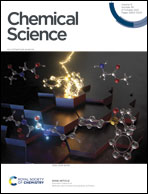Ring-opening and ring-expansion reactions of carborane-fused borirane†
Abstract
Though the reaction chemistry of three-membered ring molecules such as cyclopropanes and their heteroatom-containing analogues has been extensively studied, the chemical properties of their boron analogues, boriranes, are little known thus far. This work describes the diverse reactivity patterns of carborane-fused borirane 2. This borirane engages in ring-opening reactions with different types of Lewis acids, such as BBr3, GeCl2, GaCl3, BH3(SMe2) and HBpin, affording a series of ring-opening products, in which M–X or B–H bonds add across the B–C(cage) bond of the three-membered ring in 2. On the other hand, borirane 2 can undergo ring-expansion reactions with unsaturated molecules such as PhCHO, CO2 and PhCN to give ring-expansion products, five-membered boracycles, via a concerted reaction mechanism as supported by DFT calculations. The results of this work not only enrich the reaction chemistry of boriranes, but also offer new routes to boron-containing compounds and heterocycles.



 Please wait while we load your content...
Please wait while we load your content...